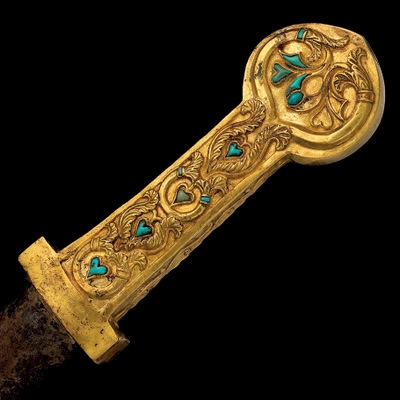Tillya Tepe
Typical of nomadic burials, the graves were dug into an earthen mound with the most important person - the chieftai - placed in the center and the secondary burials arranged roughly in a circle around him. In the northern steppes, funeral mounds were man-made constructions requiring massive movement of earth. At Tillya Tepe, however, the nomads reused an existing “hill" - actually the earthcovered remains of a fortified mud-brick temple dating from the Iron Age (1500-1300 BC).
Nomadic traditions are also reflected in the collapsible gold crown found in Tomb VI (fig. 16) five tall “trees” are inserted into small gold tubes on the inside of the diadem, a system that allowed the crown to be dismantled and easily transported.
The finds at Tillya Tepe revealed a culture that was more refined, eclectic, and Hellenized than had been expected. After reaching Bactria, nomadic artists became influenced by the diverse objects that traveled along the Silk Road. The man depicted grasping two dragons on a pendant from Tomb II (cover) wears the tunic and flowing pants typical of nomadic garb, but he has an Indian beauty mark on his forehead and a crown similar to those worn by Iranian rulers. A pair of clasps from a jacket depicts figures from Greek mythology: Dionysus, the god of wine, and his consort Ariadne are accompanied by Nike holding the wreath of victory, and drunken Silenus, Dionysus's com- panion, slouched on the ground (fig. 17).
The monstrous steed with the muzzle ofa lion, beard ofa goat, and crest ofa dragon is alien to Greek art, however, and reflects the aesthetic of the steppes. Chinese influence is evident in the chieftain`s boot buckles, each of which shows an exotic scene of chariots being drawn by dragons (fig.18). The pattern on the chariot's side suggests a woven material, and the uprights supporting the canopy resemble bamboo. Such lightweight, two - wheeled chariots are known from excavations in Mongolia and from Han Chinese burials of the first century BC. Like many of the gold objects found at Tillya Tepe, this buckle shows signs of wear. Because nomads carried all their wealth with them, often on the body, the buckle was probably used by the chieftain during his life. Most scholars believe that the adornments, jewelry, and weapons at Tillya Tepe were made locally. The turquoise and most of the other semiprecious stones used for inlays were abundant in the region, as was gold from the Amu Darya. What is most telling is that the workmanship of the gold items is similar among all the tombs, suggesting the possibility of a single workshop located nearby in northern Afghanistan.
The objects found at Tillya Tepe constitute a microcosm of the ancient world at the center of the Silk Road, where the combination of Chinese, Indian, Siberian, Persian, Greek, and Roman motifs created a lavish and distinctive style.
Today the National Museum of Afghanistan is being renovated after decades of war during which it was bombed, looted, and then desecrated by the Taliban. Thousands of fragments of smashed sculpture are being reassembled there, and the museum staff is receiving training in conservation, photography, inventory, registration, and exhibition design. It is hoped that the treasures in this exhibition will eventually be on permanent display in the refurbished National Museum of Afghanistan, which beats the inscription
“A nation stays alive when its culture stays alive."




